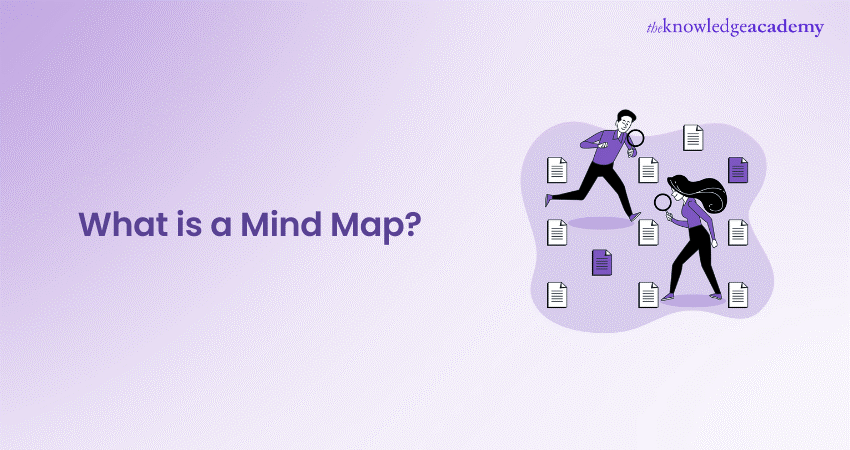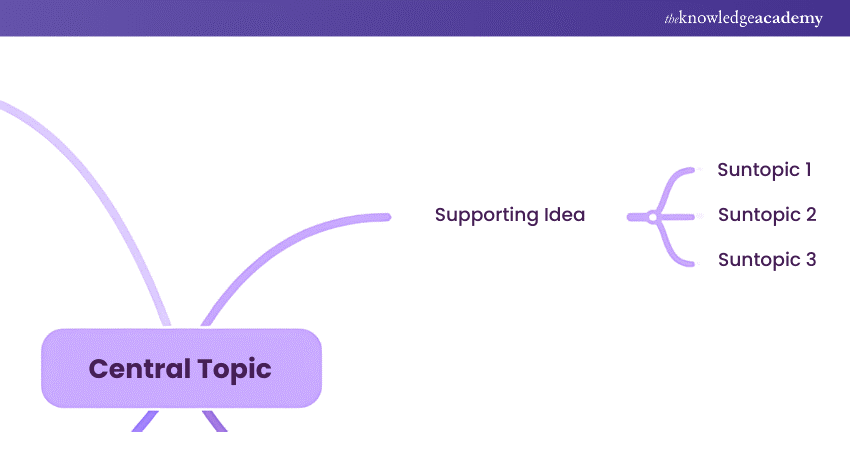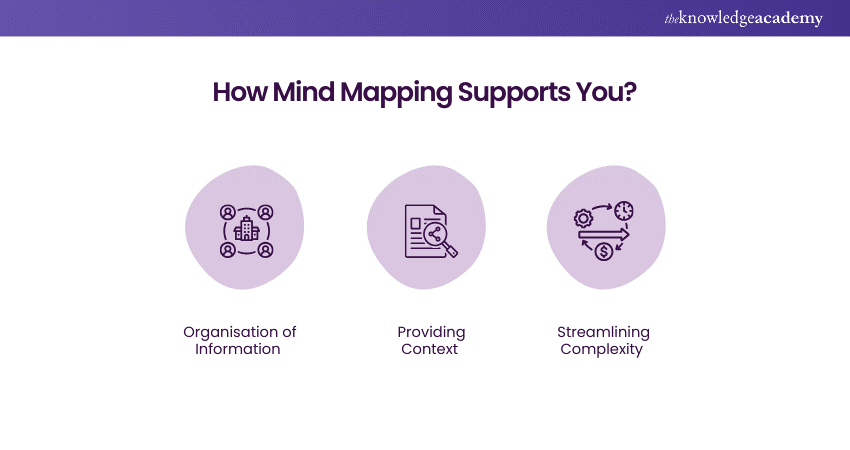We may not have the course you’re looking for. If you enquire or give us a call on + 1-866 272 8822 and speak to our training experts, we may still be able to help with your training requirements.
Training Outcomes Within Your Budget!
We ensure quality, budget-alignment, and timely delivery by our expert instructors.

Looking for a powerful way to organise your thoughts and ideas? Mind Mapping is the perfect tool for you! But What is a Mind Map exactly? Well, this dynamic technique visually structures information around a central theme, making connections clear and simplifying complex concepts.
Explore What is a Mind Map through this blog and see how it can enhance your creativity, problem-solving skills, and productivity. Discover how understanding Mind Mapping can revolutionise the way you manage ideas and achieve your goals. Dive in and transform your approach today!
Table of Contents
1) What is Mind Mapping?
2) Who uses Mind Mapping?
3) Core Features of a Mind Map
4) How to Create a Mind Map?
5) Mind Mapping Tips and Strategies
6) Benefits of Mind Mapping
7) How Mind Mapping Supports You?
8) Conclusion
What is Mind Mapping?
Mind Mapping is a visual technique that organises information around a central idea using branches for related concepts. It helps to structure thoughts, reveal connections between ideas, and simplify complex information. By using keywords, images, and colours, Mind Mapping enhances creativity, learning, and problem-solving skills.
Who Uses Mind Mapping?
Mind Mapping is widely used by students, professionals, and creative thinkers alike. Students use it to study and organise notes, while professionals employ it for project planning and brainstorming sessions. Creatives and innovators rely on Mind Mapping to unlock new ideas and solve complex problems. Its versatility makes it a valuable tool for anyone seeking to improve clarity and efficiency in their thinking processes.
Core Features of a Mind Map
Mind Mapping is a versatile tool with key features that enhance its effectiveness in organising and visualising information. Here are the core features of a Mind Map:
Single Central Topic
A Mind Map begins with a single central idea, placed in the centre of the map, from which all other related concepts branch out. This central focus ensures that all information is connected to a central theme.
Expansive Tree Structure
The tree-like structure of a Mind Map branches out from the central topic, creating a visual hierarchy of ideas. This structure helps to organise and expand upon concepts in a clear and logical manner.

Keyword Focused
Mind Maps use keywords or short phrases to represent ideas, making the map more concise and easier to understand. This keyword-focused approach enhances clarity and quick recall of information.
How to Create a Mind Map?
Before you start building your Mind Map, choose the right Mapping tool. If you're working with a team, opt for digital whiteboards or Mapping software to facilitate collaboration and ensure everyone can access and contribute to the map later. Don’t be intimidated by the blank space; your Mind Map will expand as you begin.
1) Define the Main Topic
Place the main topic in the centre of your workspace. This could be a single word or a phrase like "improving team morale" or "work culture." You might use a central image or graphic for inspiration. For example, if working on a new product, include an image from a competitor you admire or a few key phrases that define your goal.
2) Develop Subtopics
Identify three to five subtopics or themes related to your central idea. These will form the initial branches of your Mind Map. As you continue, you can add more layers of related ideas. These initial subtopics don’t need to be fully developed; they’re starting points for further exploration.
3) Link Relevant Ideas
Draw lines or use colours to connect related ideas, helping to reveal patterns and connections that might not be obvious in a traditional list. Look for recurring themes and categories, and use sticky notes, images, or different colours to highlight these commonalities. For instance, if many ideas involve outdoor activities, you might group them under a theme like “nature retreats.”
4) Highlight Key Themes and Categories
Identify the most relevant and impactful themes for your main objective. Reorganise your Mind Map to reflect these key themes and guide your ideas in a focused direction.
5) Explore Niche Ideas
Expand and refine each idea with additional research and detail. Include important context and resources to enrich the Mind Map and provide valuable information for your team and stakeholders. This ensures that all critical aspects are addressed.
Enhance your analytical and problem-solving skills with our Business Analyst Courses – Sign up today!
Mind Mapping Tips and Strategies
Mind Mapping is a powerful technique that can be enhanced with specific strategies and best practices. To make the most of your Mind Maps, consider these tips and strategies:
Collaborative Mind Mapping
Collaborative Mind Mapping can drive creativity and ensure diverse input when working with a team. Use digital tools that allow multiple users to contribute in real time, share ideas, and provide feedback. This approach fosters a collective effort, making combining different perspectives and generating comprehensive solutions easier.
Designing an Effective Mind Map
To design an effective Mind Map:
a) Start with a clear, central topic and use a hierarchical structure for branching ideas.
b) Employ keywords, images, and colours to enhance clarity and visual appeal.
c) Keep branches and subtopics concise and relevant, ensuring the map remains easy to read and navigate.
d) Regularly review and update the map to reflect new insights and changes.
Benefits of Mind Mapping
Mind Mapping offers a host of benefits beyond just being an effective brainstorming tool. It helps generate new ideas, solve complex problems, and simplify tackling challenges. Here are some additional advantages that can positively impact your team and overall work performance:
a) Reduces Stress: Eases the pressure of problem-solving and developing creative ideas.
b) Boosts Memory: Enhances retention and recall through visual and spatial arrangement.
c) Provides a Holistic View: Offers a comprehensive perspective of your project or thought process.
d) Organises Information: Minimises information overload and keeps everything neatly organised.
e) Enhances Communication: Visual representations are more engaging, flexible, and clear.
f) Promotes Critical Thinking: Encourages more analytical and critical thinking.
Join our Business Process Mapping Training and learn how to visualise and improve workflows – Register now!
How Mind Mapping Supports You?
Mind Mapping is an invaluable tool for enhancing various aspects of information management and decision-making. Here’s how it can support you:

Organisation of Information
Mind Mapping helps you systematically organise information around a central idea, creating a clear visual structure. Breaking down complex topics into manageable branches enables you to easily sort and connect related concepts. This structured approach enhances your ability to track and manage information efficiently.
Providing Context
By visually mapping out ideas and their relationships, Mind Mapping provides valuable context that aids understanding. It allows you to see how different elements fit into the bigger picture and how they interrelate. This context helps clarify complex information and supports better decision-making and analysis.
Streamlining Complexity
Mind Mapping simplifies complex information by representing it in a visual format. This approach breaks down intricate topics into more digestible segments, making it easier to identify patterns, connections, and key points. It helps you manage and navigate complexity with greater ease and effectiveness.
Conclusion
Now that you know What is a Mind Map; it's clear that mind mapping is a versatile and powerful tool that can revolutionise how you approach brainstorming, problem-solving, and project management. Visually organising information not only reduces stress and enhances memory retention but also provides a comprehensive overview of your ideas.
Transform the way you think, organise, and create by joining our Mind Mapping Training. Enhance your creativity, problem-solving skills, and productivity today!
Frequently Asked Questions

Yes, Mind Maps are excellent for memory. They use visual elements and hierarchical structures that aid in organising information, making it easier to recall. The visual nature and connections between ideas enhance memory retention and comprehension.

Yes, Mind Maps support active learning by engaging users in the process of organising and linking ideas. This active involvement encourages deeper understanding and retention of information compared to passive learning methods.

The Knowledge Academy takes global learning to new heights, offering over 30,000 online courses across 490+ locations in 220 countries. This expansive reach ensures accessibility and convenience for learners worldwide.
Alongside our diverse Online Course Catalogue, encompassing 19 major categories, we go the extra mile by providing a plethora of free educational Online Resources like News updates, Blogs, videos, webinars, and interview questions. Tailoring learning experiences further, professionals can maximise value with customisable Course Bundles of TKA.

The Knowledge Academy’s Knowledge Pass, a prepaid voucher, adds another layer of flexibility, allowing course bookings over a 12-month period. Join us on a journey where education knows no bounds.

The Knowledge Academy offers various Business Analyst Course, including Mind Mapping Training, Business Process Mapping Training and Business Analyst Fundamentals Training. These courses cater to different skill levels, providing comprehensive insights into the Business Analysis Services.
Our Business Analysis Blogs cover a range of topics related to Mind Mapping, offering valuable resources, best practices, and industry insights. Whether you are a beginner or looking to advance your skills in Mind Mapping, The Knowledge Academy's diverse courses and informative blogs have you covered.
Upcoming Business Analysis Resources Batches & Dates
Date
 Mind Mapping Training
Mind Mapping Training
Fri 10th Jan 2025
Fri 14th Feb 2025
Fri 11th Apr 2025
Fri 23rd May 2025
Fri 8th Aug 2025
Fri 26th Sep 2025
Fri 21st Nov 2025







 Top Rated Course
Top Rated Course



 If you wish to make any changes to your course, please
If you wish to make any changes to your course, please


